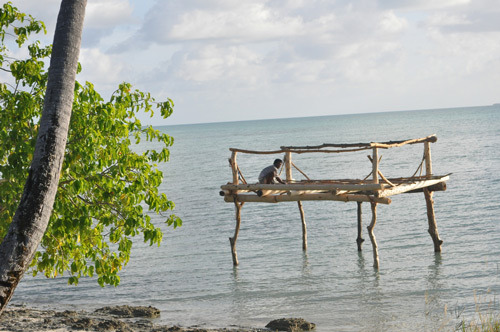A few things you may not know about small island developing States. There are currently 39 small island developing States in three geographic regions: the Caribbean; the Pacific; and Africa, Indian Ocean and South China Sea.*
These small islands have a combined population of 63.2 million people and a combined gross domestic product (GDP) of $575.3 billion.
Small islands face a unique set of challenges due to their small size and remote location. They are also highly vulnerable to climate change and natural disasters.
While they have many things in common, the standards of living among small islands differ widely, with GDP per capita ranging from $51,000 in Singapore to $830 in Comoros.
Economy
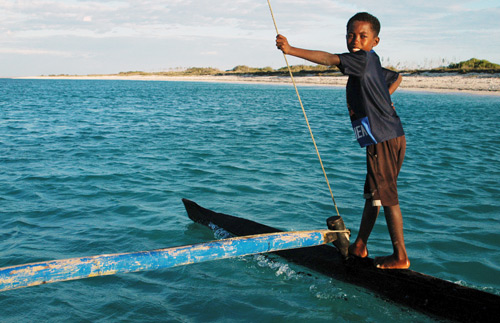
Young boy standing with a fishing stick | Source: UN
- Small island developing States benefit in different ways from an intimate relationship with the oceans. Singapore, for instance, makes use of its strategic geographic position within the global trading system. Other countries such as the Marshall Islands and Tuvalu, depend on their marine resources.
- For small islands in the Pacific, tuna fisheries contribute more than 10 per cent of GDP and in some islands more than 50 per cent of their exports. Fish also contribute at least half of total animal protein intake in some small islands.
- In Samoa and Fiji, coconut trees and their products account for 30 per cent of GDP and the majority of small-scale farmers are dependent on coconuts for their livelihoods.
- Coral reefs provide an estimated $ 375 billion per year in goods and services to the world. This includes support for marine fisheries, which provide the principal protein source for many island populations.
- Tourism is a vital sector of the economies of most small island developing States. Tourism receipts represent more than 30 per cent of their total exports; in comparison, the average for the world is just over 5 per cent.
- The Caribbean region receives more than 21 million visitors each year. If the region were a single country, it would be the third most visited in all of the Americas, behind the US and Mexico, and the 14th most visited worldwide.
- Islands are home to numerous ecosystems, from mountain forests to wetlands that provide food, fresh water, wood, fibre, medicines, fuel, tools and other important raw materials that support island livelihoods, economies and cultures.
- The Cook Islands exclusive economic zone – the territorial waters around the islands – stretches for nearly 2 million square kilometres (772,395 square miles). That’s a space the size of India. These waters are also the world’s largest designated shark and whale sanctuary.
- Small islands are the custodians of 15, or 30 per cent, of the 50 largest exclusive economic zones. Kiribati, the largest small island developing state in terms of ocean territory, has the 13th largest exclusive economic zone on Earth.
Environment
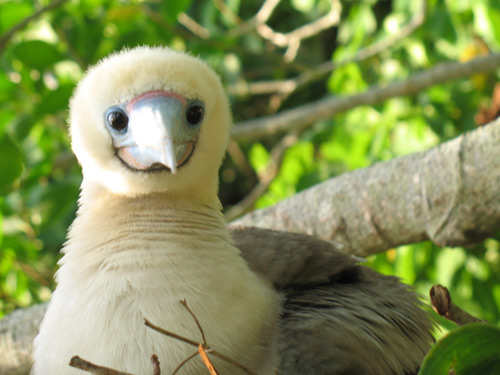
Red footed booby on a tree | Source: UN
- Small islands are rich in biological diversity and are home to many endemic species –meaning that they are found nowhere else on Earth – such as the spider Nephila in the Seychelles.
- The Seychelles, Comoros and Mascarene islands in the Indian Ocean also hold a number of critically endangered bird species.
- The Seychelles are also home to the only endemic family of amphibians: the Sooglossidae, and the Aldabra giant tortoise, one of the regions most heralded endemic reptiles.
- Kiribati is home to the Phoenix Islands Protected Area (PIPA) in the Pacific Ocean, which safeguards important nesting grounds for threatened and endangered seabirds, coconut crabs, endemic plants, and sea turtle nesting beaches. It is also one of the world’s last intact oceanic coral archipelago ecosystems, and tourist wishing to visit must first apply.
- There are no rivers in The Bahamas but the world’s third longest barrier reef and about 14. 5 per cent of the world’s coral can be found in these waters.
- It has often been remarked that islands make a contribution to global biodiversity that is out of proportion to their land area. In this sense, they can be thought of collectively as biodiversity “hot spots” containing some of the richest reservoirs of plants and animals on Earth.
- However, many of islands species have tragically been driven to extinction. Of the 724 recorded animal extinctions in the last 400 years, about half were of island species, and at least 90 per cent of the bird species that have become extinct in that period were island-dwellers.
- Islands are repositories of genetic information whose present-day biodiversity stands as a record of millions of years of evolution. This biodiversity is of great value not just to island dwellers but to humankind as a whole.
Climate Change
Polynesian canoe voyage seeks to highlight need for action to safeguard the planet | Source: UN
- While they contribute little to climate change, small islands are greatly affected by changes in climate patterns, and the rise in sea level can cause loss of land along coastlines of low-lying islands, disrupting economies and livelihoods. For example, a 50-centimeter rise in sea level will result in Grenada losing 60 per cent of its beaches, while a 1-metre rise would inundate the Maldives.
- Climate change causes coral bleaching to become an annual occurrence, leading to environmental and economic losses. For example, Dominica has reported that half of its corals are bleached, and coral bleaching in Tobago affected an average of 66 per cent of its hard corals in 2005 alone.
- Several small island developing countries, including the Maldives, Tuvalu and several Caribbean island States, are working to achieve “climate neutrality” through the use of renewable energy and other approaches.
Social Development
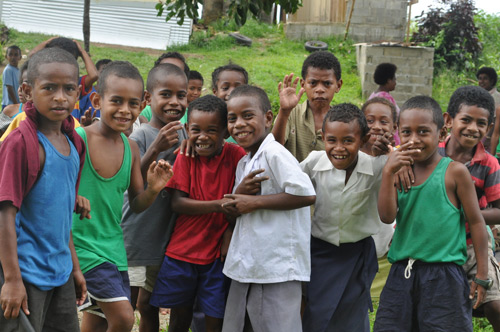
Source: UN
- Small island developing States have made considerable progress to achieve certain social development goals, including health, education, gender balance, and access to water and sanitation. However, systematic eradication of poverty has remained a challenge for most countries.
- Substantial progress has been made in reducing child mortality in countries like the Maldives, Haiti and Comoros, but rate still remain high.
- The percentage of undernourished population is declining overall, but adequate nutrition remains an issue as urbanization has increased consumption and dependency on processed foods, leading to higher rates of obesity, heart disease and diabetes.
- While general literacy rates are high among the small island developing States, it is still not universal, with Haiti, Papua New Guinea and Belize being of greatest concern.
- Another main challenge for social development has been limited human resource capacity, due to high levels of emigration among the most educated population.
Culture
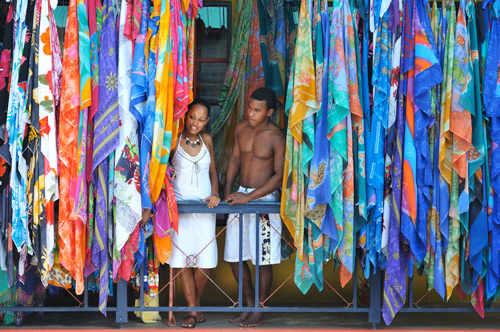
Young couple in the Seychelles market standing in the middle of hanging fabrics | Source: UN
- There are 28 World Heritage Properties in small island developing States. Nineteen are cultural, eight natural and one is a mixture of both.
- One of the inscriptions to the World Heritage List is the practice of pearling, the traditional sea-use of harvesting pearls from oyster beds, which shaped Bahrain’s economy for millennia.
- Other World Heritage Sites showcase the vestiges of the colonial past in countries such as Barbados and Fiji, while others, such as the Le Morne Cultural Landscape in Mauritius, are a testimony to resistance to slavery, as the mountain was used as a fortress to shelter escaped slaves, with physical and oral evidence to support that use.
- In spite of their small size, these countries have great diversity in cultures and languages with indigenous heritage (in the Pacific) as well as European, African, Arab and Asian influences.
- Small islands have also given the world various music genres including reggae, zouk, mambo, danzón, bouyon, calypso, soca, reggaeton and punta.
- Famous musicians from small islands include Bob Marley (Jamaica), Compay Segundo (Cuba), Omara Portuondo (Cuba), Celia Cruz (Cuba), Silvio Rodriguez (Cuba), Harry Belafonte (Jamaica), Tito Puente (Puerto Rico), Rihanna (Barbados), Nicki Minaj (Trinidad and Tobago).
- Caribbean countries hold dozens of carnivals every year, where the folklore, music and traditions are showcased. Caribbean carnivals are also held in cities around the world. Some of the most famous ones include the Notting Hill Parade in London, and the West Indian Parade in New York.
More Information
- Convention on Biological Diversity
- Pacific Islands Forum
- Small Islands Developing States Network
- UN Department of Economic and Social Affairs
- UN Educational, Scientific and Cultural Organization
- UN Environment Programme
- UN Framework on Climate Change
*Source: UN.
Read also:
Climate Change: Small Island States Face ‘Existential Threat’
Climate Change ‘Threatens Self-determination’ of Citizens in Island States
Tiny Though Some May Be, Islands Play a “Huge Role” in Sustaining Life on the Planet
‘2015 Pivotal for Finalizing Universal Climate Change Agreement’
‘Never before have the risks of climate change been so obvious and the impacts so visible’
‘Climate Change Threatens Irreversible and Dangerous Impacts’
What Is Known and What Is Not Known about Impacts of Climate Change – Report
UN Summit: Tackling Climate Change Requires “All Hands on Deck”
Climate Summit: Extreme Weather Hits Asia, Europe… a Further Indication of the “New Normal”?
Beating Climate Change, Either Lead or Get Out of the Way
No ‘Plan B’ for Climate Action as There Is No ‘Planet B’
Economic Growth Possible Even While Tackling Climate Change — Report
‘We Are Running Out of Time’, Experts Warn as Climate Change Debate Heats Up
Climate Change Impacting Entire Planet, Raising Risk of Hunger, Floods, Conflict – UN Report
Impact of Climate Change Could Reverse Decades of Development in Africa ‘Majestic’
Greenland Provides First-hand Look at Impacts of Human-induced Climate Change
Bangladesh: the Crippling Cost of Climate Change Adaptation
Looming Problems: Not Enough Energy; Too Much of Climate Change
Clean Energy, Water Strategies to Halt ‘Runaway’ Climate Change – Experts
The ‘Future We Want’, Nowhere to Be Found in Rio+20
Demand for Life’s Essentials: 50% More Food, 40% More Energy and… 35% More Water
Food Inequality Equation: 1.5 Billion Obese; 925 Million Hungry
2015 Human Wrongs Watch


